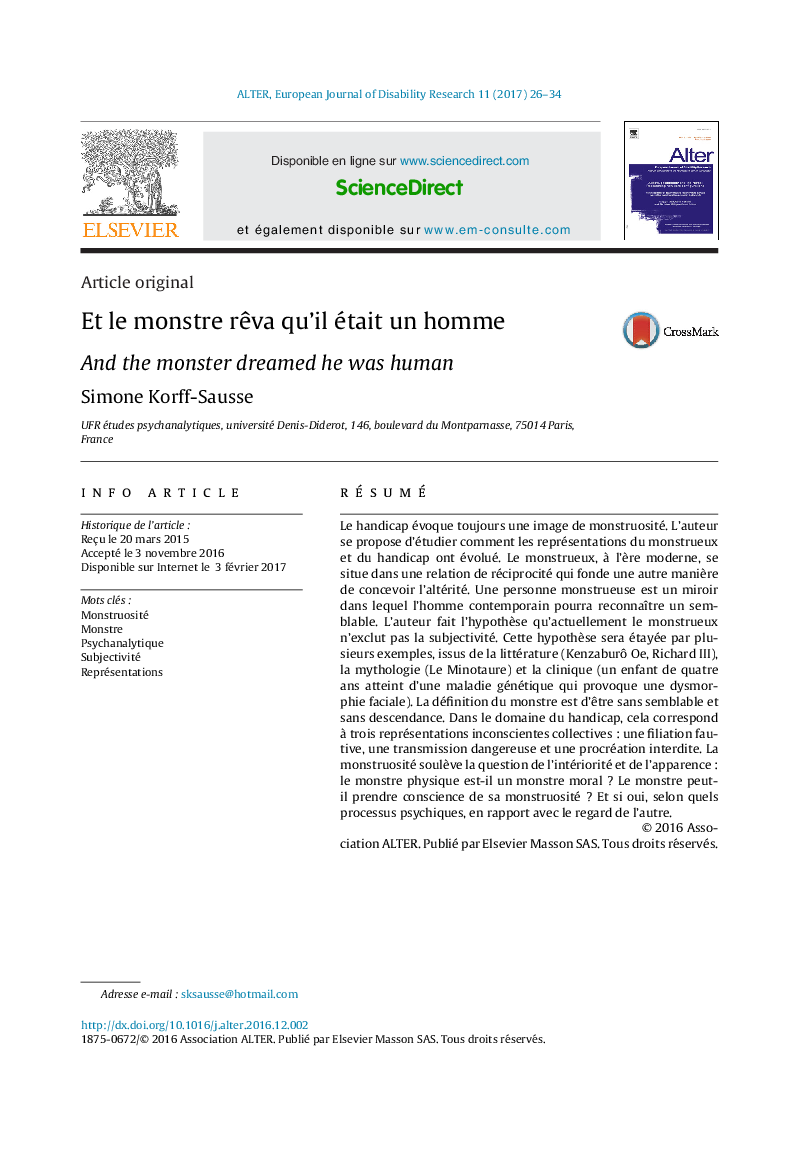| Article ID | Journal | Published Year | Pages | File Type |
|---|---|---|---|---|
| 5119822 | ALTER - European Journal of Disability Research / Revue Européenne de Recherche sur le Handicap | 2017 | 9 Pages |
RésuméLe handicap évoque toujours une image de monstruosité. L'auteur se propose d'étudier comment les représentations du monstrueux et du handicap ont évolué. Le monstrueux, à l'ère moderne, se situe dans une relation de réciprocité qui fonde une autre manière de concevoir l'altérité. Une personne monstrueuse est un miroir dans lequel l'homme contemporain pourra reconnaître un semblable. L'auteur fait l'hypothèse qu'actuellement le monstrueux n'exclut pas la subjectivité. Cette hypothèse sera étayée par plusieurs exemples, issus de la littérature (Kenzaburô Oe, Richard III), la mythologie (Le Minotaure) et la clinique (un enfant de quatre ans atteint d'une maladie génétique qui provoque une dysmorphie faciale). La définition du monstre est d'être sans semblable et sans descendance. Dans le domaine du handicap, cela correspond à trois représentations inconscientes collectives : une filiation fautive, une transmission dangereuse et une procréation interdite. La monstruosité soulève la question de l'intériorité et de l'apparence : le monstre physique est-il un monstre moral ? Le monstre peut-il prendre conscience de sa monstruosité ? Et si oui, selon quels processus psychiques, en rapport avec le regard de l'autre.
Disability always evokes an image of monstrosity. The author proposes to study how representations of the monstrous and of disability have evolved. The monstrous, in the modern era, is situated in a relationship of reciprocity that founds another way to conceive of alterity. A monstrous person is a mirror in which contemporary man might be able to recognize a fellow creature. The author makes the hypothesis that the monstrous does not preclude subjectivity. This hypothesis is backed up with several examples, from literature (Kenzaburô Oe, Richard III), mythology (the Minotaur) and clinical cases (a four-year-old child suffering from a genetic disease causing facial deformation). The definition of the monster is to be without fellow creatures and without descendants. In terms of disability, this corresponds to three unconscious collective representations: faulty filiation, dangerous transmission and forbidden procreation. Monstrosity raises the question of interiority and appearance: is the physical monster a moral monster? Can the monster become conscious of his monstrosity? And if so, through what psychic processes, in relation with the gaze of the other?
